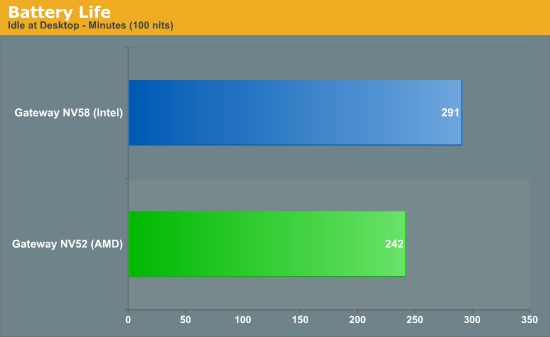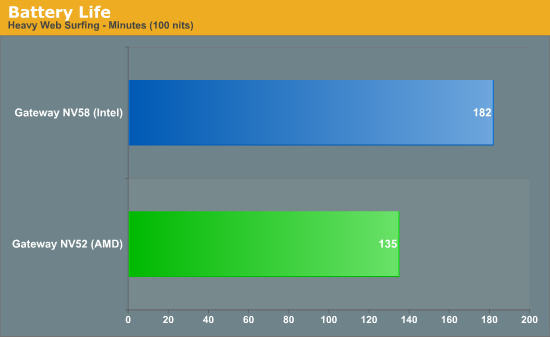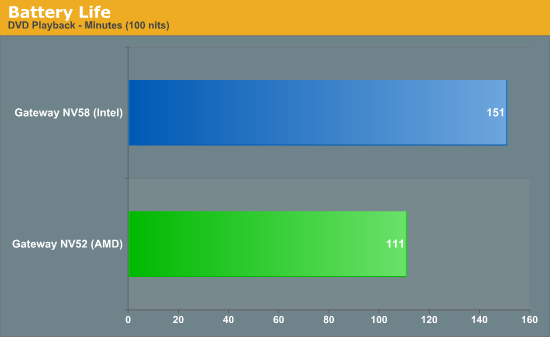AMD vs. Intel: Battery Life Investigated
by Jarred Walton on August 5, 2009 5:00 PM EST- Posted in
- Laptops
AMD vs. Intel: Battery Life Investigated
Both laptops used identical power saving settings under Windows Vista's "Balanced" plan (with some minor tweaks to the defaults on both systems). We ran five different test scenarios, ranging from best-case idle battery life at the Windows desktop to a far more taxing DVD/x264 playback results, along with two different Internet surfing benchmarks. One Internet benchmark represents a "light" load while the other has far more Flash content and represents a "heavy" load. We set both LCDs to 100 nits brightness (40% in this case) and completed a couple charge/discharge cycles to break in the battery before beginning our tests. Here are the results.





Considering these systems are as close as we can get to "identical", AMD takes a real pounding in battery life testing. The closest result (the idle test) has the Intel platform providing 20% more battery life, while the best Intel results (DVD playback and heavy web surfing) give about 35% more battery life. Averaging all five results, the Intel-based NV58 delivered 28% more battery life than the AMD-based NV52. Ouch.
Obviously, despite having identical clock speeds there are some real differences between the two processors. For one, Intel's T6500 is a 45nm part compared to the 65nm QL-64 (not that AMD has 45nm parts yet). We also don't know how much of an impact the various chipset and motherboard components might have. What we do know is that AMD's current mobile processor lineup consists of dual-core CPUs that range from 2.00GHz up to 2.50GHz, with most having a 31W TDP to 35W TDP rating; the TK-42 is a 20W 1.60GHz part and the QL-62 is a 25W 2.00GHz part. Intel on the other hand has many more options. 10W dual-core CPUs are available with clock speeds of 1.06GHz to 1.60GHz; 17W chips have clock speeds ranging from 1.33GHz to 2.13GHz; 25W processors start at 2.26GHz and end at 2.66GHz; and the 34/35W parts cover the gamut from 1.60GHz all the way up to 3.06GHz… and that's just the Core 2 Duo parts! Pentium Dual-Core, Core 2 Quad, and Core 2 Extreme parts are also available to flesh out the spectrum. Then again, some of those parts cost twice as much as the Gateway NV52 just for the CPU.
When Intel released Banias and the Centrino platform in March 2003, they started a revolution in their approach to mobile processor design. Power and efficiency became the focus rather than pure clock speed, and the result has been much better mobile processors when it comes to performance per Watt. Unfortunately for AMD, they appear stuck with the old way of doing things: build a generic architecture and then optimize it for power requirements on mobile chips. Essentially the same core K8 architecture that launched in 2003 continues to power AMD's mobile offerings, and while the ensuing shrink to 65nm has helped there's still a lot of ground to make up. AMD-based laptops are still more than fast enough for most users -- and let's make this clear, a $500 dual-core AMD laptop is tons faster than anything using Intel Atom (though it uses more power, obviously) -- but Intel has the upper hand. It's unfortunate there's not more competition in the mobile processor space, or we might start really start to see prices drop!
For now, if you're looking for an inexpensive laptop (not a netbook), you need reasonable battery life, and you don't care about graphics performance we suggest saving up the extra $50-$100 for an Intel-based system.










80 Comments
View All Comments
ltcommanderdata - Wednesday, August 5, 2009 - link
It's highly unlikely that a TSMC 55nm process has an advantage over Intel's 65nm process other than size.http://www.realworldtech.com/page.cfm?ArticleID=RW...">http://www.realworldtech.com/page.cfm?ArticleID=RW...
In fact, in terms of performance, TSMC's originally planned 45nm process would be required to match Intel's 65nm process. Of course, TSMC has since skipped 45nm and went directly to 40nm. Still, Intel's processes tend to be a generation ahead of the more generic processes at TSMC, with preliminary data on TSMC's 32nm process showing it behind Intel's 45nm process in terms of performance. Which of course means that Intel making Arrandale's IGP or Larrabee on 45nm won't be a performance limitation, rather it's all up to design.
Alexstarfire - Thursday, August 6, 2009 - link
This isn't about performance, it's about power usage. I'm pretty sure that a 32nm process is going to generally use less power than a 45nm process regardless of performance or design. I could be wrong though. I don't exactly know all the ins and outs of microprocessors.ltcommanderdata - Thursday, August 6, 2009 - link
I'm pretty sure in this case performance and power are closely correlated because you can trade off between the 2. I believe they mean performance in a manufacturing process by describing how much current the transistor can transfer when it's on at a given drive voltage along with how much current the transistor leaks when it's off. Of course, higher on current (to do work) and lower off current (leakage) is better. In the case of the graph, it's drive voltage over on current so a higher on current will result in a lower number. Hence, Intel's 45nm process can have a higher on current for a given voltage than TSMC's 32nm process. This is important for high performance processors. For low-power processors, this also means that Intel can use lower drive voltage to save power (like undervolting), while still maintaining a higher current to do work than their competitors' process.imgod2u - Wednesday, August 12, 2009 - link
This isn't necessarily true. Keep in mind the FET is inherently a non-linear device. There is a limit (especially for digital logic) where you simply can't lower the operating voltage anymore without drastically affecting slew rates to the point of breaking the device.This is why multi-Vt processes are available instead of just putting the slower paths on a lower VDD rail. The gate dielectric thickness (tox) is offered in various levels to balance between performance and leakage. It's then up to the designer to choose which Vt device to use in which gate.
Now it could be that Intel's 45nm (which uses both a high-k gate dielectric as well as gate-replacement) is simply superior to TSMC's 32nm all around. I've not looked up the data. But higher-performance is usually inversely proportional to low-power capabilities of the process itself.
Pneumothorax - Thursday, August 6, 2009 - link
Smaller process does not always equal smaller power usage. Don't you remember Presscot? (The first 90nm P4, AKA pressHOT) Used more power than the preceding generation due to power leakage and design.ltcommanderdata - Thursday, August 6, 2009 - link
Well of course process isn't the only factor, but I mentioned it since Jarred specifically mentioned that TSMC's 55nm process might help provide an advantage over Intel's 65nm process. In this case, it looks like Intel's 65nm process would have been competitive against TSMC's canceled 45nm process, so TSMC's 55nm process would be behind.DigitalFreak - Wednesday, August 5, 2009 - link
Can't say that I'm at all surprised, for exactly the reasons you mentioned.Voldenuit - Saturday, August 8, 2009 - link
Agreed. It's been conventional wisdom for a long time now that intel laptops outlast amd laptops, but it's always good to verify (and check up on) the claim.Next: how about OS contributions to battery life?
I'd love to see battery life on the same notebook in WinXP vs Vista vs Win7. If AT could throw in OSX via hackintosh, that would be even more interesting, as you guys have found that OSX is superior to Windows in battery life on Apple hardware, but it would be interesting to ascertain if that is due solely to the OS vs BIOS/fimrware/more low level stuff.
I just got back from an intercontinental flight, and was able to eke close to 9 hrs out of my Thinkpad X300, using the 6-cell battery and 3-cell Ultrabay battery (albeit with wifi off; mainly reading and some minor document editing).
JarredWalton - Saturday, August 8, 2009 - link
The one time I looked into XP vs. Vista battery life, it actually wasn't substantially different on the same laptop (within a few percent, which is margin of error on battery tests). I may try to do a WinXP vs. Vista vs. Win7 comparison in the near term, but OSX is sort of difficult to do properly with a Hackintosh. I've heard Apple plays with the CPU voltages a bit more using some direct access to the hardware, but honestly I'm not sure Windows PCs ever fully enter deep C-states.Stay tuned... full review is still pending, and then I'll see about playing with other OSes.
Voldenuit - Tuesday, August 11, 2009 - link
Neat. Looking forward to it.Course, I'm one of those users who "cheat" w/ undervolting and forcing C-states with RMClck (or NHC depending on my fancy). ^_^.